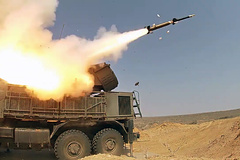19FortyFive: Russian Pantsir air defense system could "grow long claws"
The Russian air defense system "Pantsir" could "grow long claws", allowing it to defeat the attacking unmanned aerial vehicles (UAVs), says the American publication 19FortyFive.
The publication claims that the experience of combat use of this air defense system in Syria, Libya and Nagorno-Karabakh has not been particularly successful. The publication notes that the "Shell" was often used to cover other air defense facilities, often proved vulnerable to Turkish Bayraktar TB2 UAVs and required modernization.
19FortyFive writes that the upgraded Pantsir-SM received an improved radar with an active phased array antenna (AFAR), which increased the maximum target detection range to 75 kilometers, as well as the 57E6M-E missile with a flight range of up to 40 kilometers.
"The speed [of the missile] has been increased by 30 percent to an incredible 5 Mach numbers, which makes it possible to intercept targets moving at speeds up to 2.9 Mach numbers, or one kilometer per second," the publication says.
The publication notes that in terms of target detection range, the Pantsir-SM surpasses the range of the Bayraktar TB2 missile armament, pushing "hidden unmanned aerial vehicles even further," while the high speed and range of missiles potentially allows the Russian system to destroy supersonic aircraft and missiles.
However, the publication admits that the "Shell-SM" may still have difficulty coping with small UAVs.
In December 2021, the head of the military air Defense (Air defense) of the Russian Armed Forces, Lieutenant General Alexander Leonov, announced that the development of a modification of the Pantsir-SM-SV anti-aircraft missile and cannon complex (ZRPC) on a tracked chassis for Ground and Airborne troops is planned to be completed next year.

